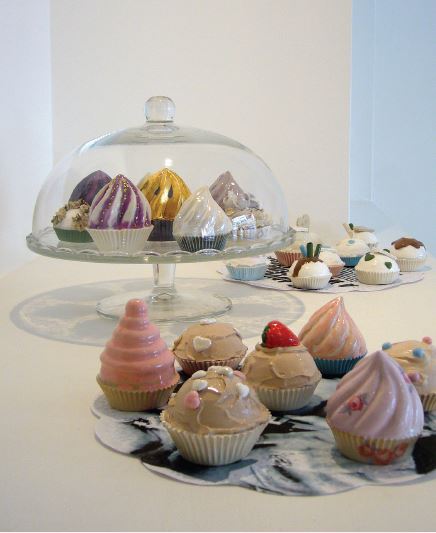Academy of Fine Arts and Design in Bratislava
Mária Nepšinská
Linda Viková – 101 Cupcakes (ceramics)
Cupcake (for the Americans) or Fairy cake (for the English) is a small muffin-like cake. It is baked in a small, often richly decorated paper cup. Initially, they appeared at the table in the 19th century. Now, they are presented as one of visual symbols of the American pop culture. Pop art artists often use it (for example, ceramicist David Gilhooly). Objects designed by Linda Viková are part of the group of reactions to the American pop art techniques, particularly to imitating of materials. She masters various ceramic techniques and technologies assisting in producing the illusion of reality, namely the collection of 101 special-shape ceramic cupcakes.
Lucia Bartková – Transformation (jewellery)
Lucia Bartková transforms a fashion jewellery object in a computer, makes it real by the FDM technology (Fused Deposition Modelling) and transforms it into the jewellery using a traditional manual silver-processing technology. The purpose was to compare and allow mutual communication of two jewellery production processes. And, to find answers, by experimenting, to the following questions: Can a machine replace a human being? Are we able to perceive current problems of mass production? How are we influenced by man-made artworks and what does an artist want to tell us through the artworks? She is fascinated by the magical technology and, on the other hand, she knows about the consequences for creative work which starts to lack communication with a material.
Alžbeta Presová – The Last of the Mohicans (clothing design)
The Last of the Mohicans – this is how women from the region of south Moravia call themselves. They were born after 1910 and wear folk costumes until today. Clothes they wear are arranged into layers, they are full of colours, with neck-fastening, puff sleeves, wool coats and popular head cloths. A collection of eight women’s clothes is reflection to the folk costumes of women from the Slovácko region, the region of birth of the author. It is a perfect arrangement of clothes, pieces of which are interconnected and complement each other. Elements of them, silhouettes or simple lines of current clothing style, capture the attention of a viewer. The folk-style collection makes a unique appearance in today´s fashion. Selection of a folk costume and simplified vocabulary indicate the trend for further clothes.
